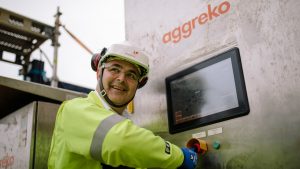Johan Sverdrup Powered from Shore
 Today, 9 October, the Norwegian Minister of Petroleum and Energy, Kjell-Børge Freiberg, officially opened the power-from-shore solution which will provide the Johan Sverdrup field in the North Sea with electricity for more than 50 years. Power from shore makes Johan Sverdrup one of the most carbon-efficient fields worldwide.
Today, 9 October, the Norwegian Minister of Petroleum and Energy, Kjell-Børge Freiberg, officially opened the power-from-shore solution which will provide the Johan Sverdrup field in the North Sea with electricity for more than 50 years. Power from shore makes Johan Sverdrup one of the most carbon-efficient fields worldwide.
The giant development in the North Sea has been through the busiest installation campaign ever for a field in the North Sea. Today Johan Sverdrup reached another milestone, when power from shore was officially switched on about a year before production start-up. With electric power supplied from shore Johan Sverdrup operations can be run without the use of fossil fuels, which makes it one of the most carbon-efficient fields worldwide.
The Minister of Petroleum and Energy, Kjell-Børge Freiberg, had the honours of switching off the temporary generators which had supplied the field with electricity during the first months of the installation campaign offshore. And after the four generators had quietened down, the milestone was celebrated in the traditional offshore style with coffee and cake.
“This is an important day for Equinor and the Johan Sverdrup partners, so it is a great honour to get help from none other than the Minister with this final task to fully operationalise the power-from-shore solution,” says Jez Averty, Senior Vice President for operations in the south of the North Sea. “With estimated resources of up to 3.2 billion barrels, and a production horizon of more than 50 years, it is key that Johan Sverdrup production is as effective as possible with the lowest possible emissions. Low carbon production is a key element of the company’s strategy and fully aligned with our roadmaps for climate and for the Norwegian continental shelf,” says Mr Averty.
Johan Sverdrup full-field production is estimated to reach 660,000 barrels of oil per day at plateau, with a break-even of less than 20 dollars per barrel, and with CO2 emissions of only 0.67 kg per barrel. Power from shore to Johan Sverdrup will help reduce emissions by an estimated 460,000t of CO2 per year, equivalent to the emissions of 230,000 private cars each year. Working closely with partners and suppliers, Equinor has taken initiatives to enable the supply of power from shore already in the commissioning phase offshore. With several energy intensive operations planned prior to production start-up – including the tieback of the eight predrilled production wells – the early supply of electricity from shore helps further reduce the carbon footprint of the project. The Johan Sverdrup partnership has also, in collaboration with the supplier Master Marine, taken steps to ensure that the temporary accommodation rig Haven – where most of the offshore workers currently live – is also supplied with power from shore during the remainder of the project finalisation stage.
In phase 1 of the Johan Sverdrup development the power-from-shore solution has a capacity of 100MW, based on a production capacity of up to 440,000 barrels per day. In Johan Sverdrup phase 2, with start-up expected in Q4 2022, the power from shore capacity will be expanded with 200MW, giving a total capacity of 300MW. This enables Johan Sverdrup to facilitate access to power from shore to the other fields at Utsira High – Edvard Grieg, Gina Krog og Ivar Aasen. The expanded power capacity will also be needed for the added Johan Sverdrup production capacity of 220,000 barrels per day, and the total full field production capacity of 660,000 barrels daily.






